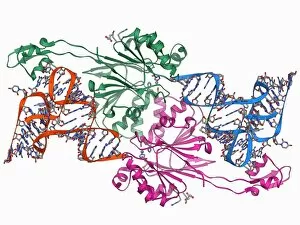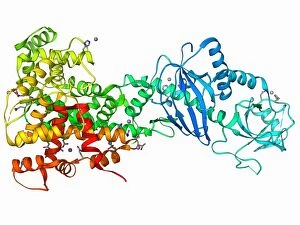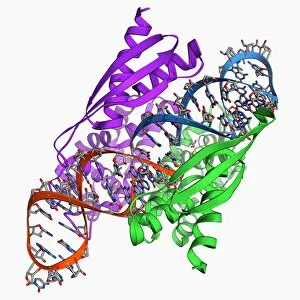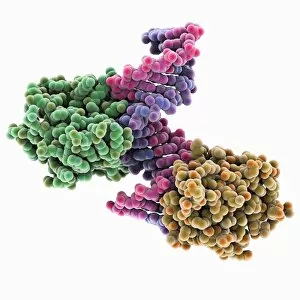Ribonuclease Collection
"Exploring the Intricate World of Ribonuclease: Unraveling RNA-DNA Hybrids and Molecular Models" Ribonucleases, commonly known as RNases
All Professionally Made to Order for Quick Shipping
"Exploring the Intricate World of Ribonuclease: Unraveling RNA-DNA Hybrids and Molecular Models" Ribonucleases, commonly known as RNases, play a crucial role in various biological processes involving RNA. One fascinating aspect is their interaction with RNA-DNA hybrids, where these enzymes exhibit remarkable specificity and efficiency. The molecular model F006/9620 showcases the intricate structure bound to an RNA-DNA hybrid, providing insights into its mechanism. Another intriguing complex is the RNA exosome complex (F006/9620), which acts as a cellular machinery for degrading unwanted or damaged RNAs. Understanding its composition and function can shed light on vital cellular processes such as gene expression regulation. The captivating image F006/9591 portrays ribonuclease bound to transfer RNA (tRNA). This interaction highlights how these enzymes participate in tRNA processing and quality control mechanisms within cells. Delving deeper into the world of ribonucleases, we encounter the molecular model F006/9589 depicting an essential player in gene silencing - the RNA interference protein. Its structural intricacies hold secrets about how it recognizes specific target RNAs and initiates their degradation. Double-stranded RNA-ribonuclease III (F006/9585) offers another glimpse into this enzyme's versatility by showcasing its ability to cleave double-stranded RNAs precisely. Such knowledge aids our understanding of viral defense mechanisms and post-transcriptional gene regulation pathways. Inhibitors are valuable tools for studying enzyme functions, as illustrated by ribonuclease bound to inhibitor (F006/9287). Investigating these interactions helps us design potential therapeutic agents targeting aberrant ribonuclease activity associated with diseases like cancer or neurodegenerative disorders. Moreover, exploring the exosome complex's molecular model provides further insight into its architecture and functioning within cells. By unraveling this intricate machinery, we can comprehend its role in RNA processing and degradation pathways.







